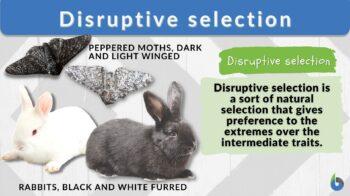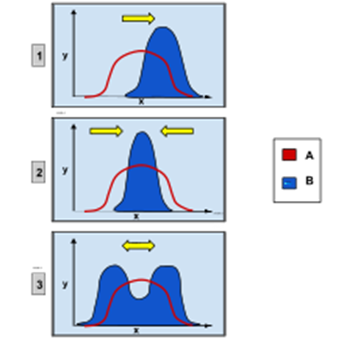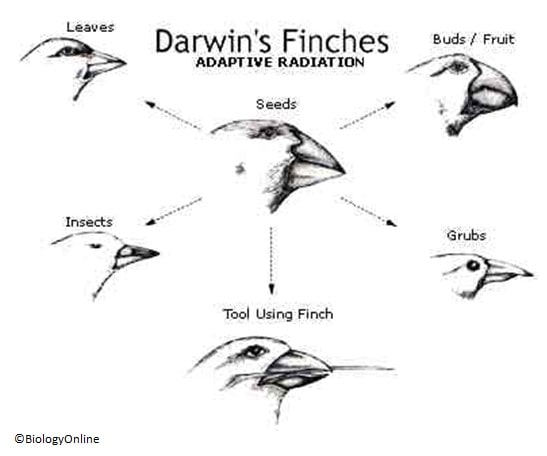
Disruptive selection
n., [dɪsˈɹʌptɪv səˈlɛkʃən]
Definition: type of natural selection where extreme traits are favored over the intermediates
Table of Contents
An evolutionary process known as disruptive selection (or disruptive natural selection) causes a population to become genetically distinct. Disruptive selection is a form of natural selection.
Because of disruptive selection, organisms with intermediate qualities will have a reduced capacity for reproduction, whereas those organisms with extreme traits will be able to increase their rate of offspring production. This increases the frequency of the alleles that are responsible for the extremely different traits. Let us further understand and define disruptive selection below.
Disruptive Selection Definition
Disruptive selection, which also goes by the name diversifying selection, refers to a form of natural selection occurring in a population where extreme traits are favored over intermediate traits. Disruptive selection takes place when more extreme phenotypes (or genotypes) within a population have a fitness advantage over intermediate individuals.
In disruptive selection, the population is separated into different groups by an increase in traits variant. The conclusion of these scenarios, a higher percentage of individuals, at both ends of the distribution curve, receive peripheral character value. Below is the disruptive selection graph.

Typically, high-density populations show disruptive selection. In these communities, resources are becoming rarer, and the intraspecific competition is intensifying. This intraspecific struggle can allow the variations between species to have a greater impact on the survival of each organism.
In a low-population-density setting, selective forces that weren’t previously taken into account may have an impact, and the resulting disruptive selection might cause the fragmentation of the population. By doing this, natural populations are often moved to different niches, which makes them less competitive. This results in sympatric speciation, which happens when populations inhabit the same area.
Examples of Disruptive Selection
Let’s say there is a lot of rabbit population. Two incompletely dominant features determine the color of rabbits: white fur and black fur are represented by “b” and “B” respectively.
The black fur of a rabbit in this population would be carried by those with the genotype BB, the gray fur, which is the combination of B and b, thus, with the genotype Bb, and the white fur of those with the genotype bb.
If the group of rabbits lived in an area where both white and black rocks are available, then black fur and the white fur rabbits could easily obscure themselves from the predators among the black and white rocks respectively. However, grey rabbits would stick out in any environment zones, making them more vulnerable to predation.
Selective pressure of this kind would have a disruptive effect on our hypothetical rabbit population, favoring white or black fur over grey fur. For example, this is a case of disruptive selection due to the disadvantage of heterozygotes (under dominance).
Here are some examples of disruptive selection in the wild:
Disruptive selection in aquatic animals
There are many examples of disruptive selection in the underwater world. One example of disruptive selection is dark and light-colored oysters. Both dark-colored oysters and light-colored oysters have camouflage advantages. Light-colored oysters will blend with the rocks and dark-colored oysters can hide under the rock shadow. The result is that the intermediate-colored oysters will be most susceptible to being preyed upon. This gives a disruptive selection advantage to dark-colored oysters and light-colored oysters to reproduce.
Disruptive selection example in humans
An example of disruptive selection in humans is their ability to tolerate the sugar lactose in milk. After weaning, an enzyme named lactase, which helps in the digestion of sugar in milk is no longer produced by the intestines in most regions of the world, making adults unable to consume milk. Due to their inability to metabolize lactose sugar, these individuals have symptoms such as bloating, stomach cramps, diarrhea, flatulence, vomiting, and nausea.
Approximately 70% of European individuals can safely digest milk. This happens because they have a regulatory mutation in the DNA region that governs the expression of the lactase gene. This DNA modification enables the lactase gene to be activated and continue the synthesis of lactase after weaning. This shift in genetic basis may have occurred between 5-10 thousand years ago. (YourGenome.org, 2021) As a result, it disturbs the natural equilibrium of gene frequencies.
Finches on Santa Cruz Island
The Galapagos Islands are home to a natural population of birds often referred to as Darwin’s finches or Galapagos finches. There has been much study of birds, and different evolutionary trends have been identified amongst bird groups living on different islands.
Birds have been intensively researched, and various patterns of evolution have been observed among populations on distinct islands. It has been found that disruptive selection has led to the diversification of finches on Santa Cruz Island. For generations, intermediate beak sizes have been affected owing to forces of disruptive selection.
The end outcome is a population where medium-sized beaks are very rare. It has been shown that the beak size of some finches affects their mating calls. The length of one’s beak is useful for more than simply picking up morsels of food. Scientists have uncovered evidence that many bird species are evolving from a single ancestral population that lived in colonies.

Disruptive Selection in Plants
In the late 1960s, renowned biologist John Maynard Smith put out the idea of disruptive selection as a technique for the evolution of plant species. The concept is easily understood and has been utilized in numerous disruptive selection examples ever since.
Individual genes are responsible for controlling a wide variety of plant characteristics, such as the color of pea pods. When a population of plants is subjected to a process of disruptive selection, a very few individuals that are most likely to be in an intermediate genetic state are those that are heterozygous (i.e., possessing two or more different types of alleles for a particular gene).
Homozygous individuals, on the other hand, have two copies of the same allele for a certain trait. Two copies of the same allele, regardless of whether or not it functions, will result in a phenotype that is at the most end of the range. These individuals will have an advantage during the disruptive selection process, as they will be protected when compared to one with intermediate phenotypes. They will also breed more.
The creatures may diverge to the point where they can no longer reproduce with one another over time, thus, depicting speciation by natural and sexual selection. In many cases, the intermediates served the purpose of acting as a passageway for the transfer of genes between the two populations. Speciation can take place in the presence of disruptive selection even in the absence of intermediates.
Sympatric Speciation
Before understanding the concept of sympatric speciation, it is necessary to be familiar with the other types of evolution. The process of speciation can occur in one of four ways: allopatrically, parapatrically, peripatrically, or sympatrically. The fourth type of speciation, known as sympatric speciation, differs from the previous three in that it does not require physical separation.
Sympatric speciation is a kind of speciation that happens when two populations of the same species coexist in the same geographical area but undergo independent evolutionary processes to the point where they are unable to interbreed and are therefore considered to be separate species.
It differs from other types of speciation where new species form as a result of a geographic barrier or movement splitting a population into groups. Although it is possible to observe sympatric speciation in a wide variety of organisms, such as cichlid fish, apple maggot fly, and bacteria, it is not always easy to determine whether or not sympatric speciation has taken place in nature.
Jerry Coyne and H. Allen Orr have come up with four criteria that can be used to determine whether or not species have formed in a sympatric manner:
- The ranges of the species must overlap extensively with one another.
- There must be complete differentiation of species (i.e., the two species cannot interbreed).
- The species in issue must either be sister species, which are species that are most closely related to one another, or members of a monophyletic group, which is a group that consists of an ancestor and all of the descendants of that ancestor. In other words, if there are more than two species that have descended from the original species, then all of the descendant species, not just some of them, need to be included.
- The history of the species’ geographic range and evolution must make allopatry seem relatively unusual, given that allopatric speciation is significantly more common than sympatric speciation.
Peppered moths in England are one of the most well-known and well-studied examples of sympatric speciation where two major types of populations emerged — dark-winged moths that are more frequently seen in industrial areas (darker areas due to environmental pollution) and white-winged moths more common in rural areas. Intermediates are rarely seen in either location.

Because it arises when different subpopulations with the same species inhabit the same area or have overlapping ranges, sympatric speciation is a rare process that sets itself apart from other types of speciation. Even if the territory that the creatures reside in is the same, they are still able to divide into two distinct groups. Eventually, they will become so genetically dissimilar from one another that they will no longer be able to breed with one another. It is considered to be a different species when members of one group are unable to reproduce with members of another group.
Significance
The process of disruptive selection is significant because it has the potential to generate such a high level of variation in a population that it leads to the evolution of new species (via speciation), even including ecological sexual dimorphism. The process through which a population’s genetic make-up alters throughout a long duration, which may be the result of disruptive selection, is referred to as evolution.
The disruptive population was involved in one of evolution’s “cardinal cases” namely the finch populations that Darwin demonstrated in the Galápagos. Therefore, it is of a particularly significant role in the history of research on evolution. He noticed that the many species of finches were sufficiently identical to one another to have, in all likelihood, descendants of only one species. The size of their beaks, however, varied significantly among individuals.
This variance appeared to be related, in an adaptive manner, to the seed size that was accessible on the various islands (small beaks for small seeds, big beaks for big seeds). Beaks of medium size were unable to successfully retrieve little seeds and were not robust enough to handle larger seeds, making them ill-suited for their environment.
Although disruptive selection can indeed result in the formation of new species, the method through which this occurs is neither as rapid nor as simple as those, that underlie other types of evolutionary change or speciation.
This serves as an introduction to the concept of gradualism, which can be defined as the gradual but steady accumulation of changes over extended periods. This is mostly due to the fact that the results of the disruptive selection are considerably less dependable than those of directed selection (directional selection favors individuals at only one end of the spectrum).
The geographical, ecological, and reproductive isolation of the finches served as the driving external force in this scenario. Because of this, we conclude that disruptive selection is impossible and that, instead, it is typically the result of directional stabilizing selection and disruptive selection, or species being geographically isolated.
Watch this vid about disruptive selection:
Frequently Asked Questions
What is disruptive selection?
Sometimes called diversifying selection, disruptive selection is a type of natural selection that favors both extremes at the expense of the average.
How does disruptive selection occur?
The variability of a characteristic within a population serves as the foundation for disruptive selection. If a gene had only one allele, then there would be no variety in the quantitative traits that it originated, and selection would not be able to act on those differences. The majority of genes have a large number of different alleles, each of which can perform a unique set of functions.
The effects of all of these distinct alleles working together in a population, together with the effects of the other genes, cause characteristics to be distributed in a variety of different forms, sizes, and patterns. Continuous characteristics are those that can be manifested in an almost uncountable number of various ways.
A characteristic is said to be discrete if it can be found only in separate things. Height would be an example of a continuous property, while eye color is an example of a discrete attribute.
In either case, a large amount of variation exists for the majority of characteristics because of the interplay between different genes and alleles. The characteristics that fall in the center of the spectrum are the ones that are targeted by disruptive selection.
Answer the quiz below to check what you have learned so far about disruptive selection.
Reference
- YourGenome.org. (2021). “A catalogue of human genetic variation.” Retrieved 01 July, 2022, from https://www.yourgenome.org/stories/are-humans-still-evolving.
- Siepielski, A. M. (2021). “Disruptive Selection.” Retrieved 01 july, 2022, from https://www.oxfordbibliographies.com/view/document/obo-9780199941728/obo-9780199941728-0059.xml.
©BiologyOnline.com. Content provided and moderated by Biology Online Editors.


